|
English Irish
White triangle on chest with the front feet white and back
feet white to half their length. The triangle on chest to be of good size, clear and devoid of brindling, not to extend in
a streak down the belly, occupying all the space between the front legs.
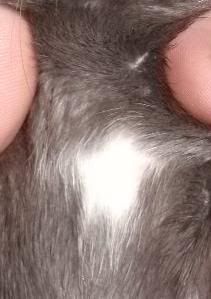
Irish
Markings are the white underside, with four white feet and a white tail tip. The under marking should be a pure
clean white, of moderate size and as even in shape as possible, not extended onto the legs, sides or chest. The tail should
be colored for most of its length, with a white tip of no more than one-fourth of its total length.
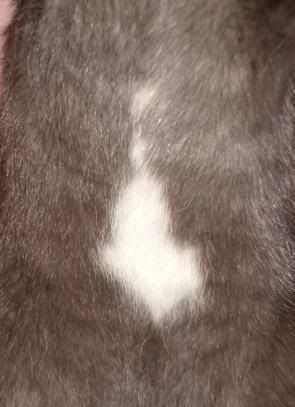
Banded
The rat should have as symmetrical of markings as possible. The chest,
belly, sides and all legs should be completely white. The band of color continues from the pigmented area of the head onto
the shoulders. The band should be about as wide as the rat's head is.
Variegated
The head and shoulders to be
of any recognized color with a white blaze on the forehead. The variegation to cover the body from the shoulders to the tail
including the sides and tail. Belly fur to be white, devoid of creamy tinge or staining.
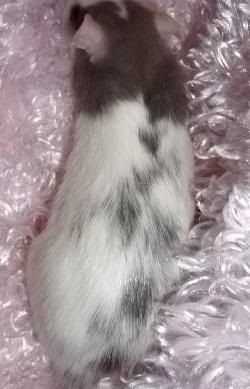
Bareback
Bareback rats may be shown in any recognized color and will have
markings like the Hooded rat but without a spine marking. The back, sides, legs, and feet should be a pure, clean white, free
from spots or brindling. The hood should cover the head, neck and shoulders without a break, showing white on top of head,
throat or chin, and should run in an even line around the body.
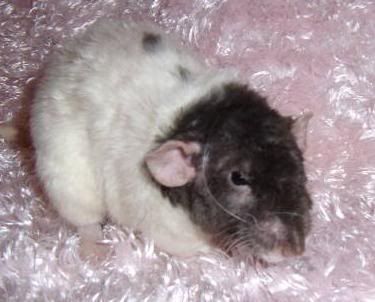
Capped
The body should be a pure clean white, free from spots or brindling,
with a colored head. The color should be confined to the head area only, not appearing on the throat area. The cap should
be free of ragged edges or brindling, follow the line of the lower jawbone in an even line and not extend past the back of
the ears.
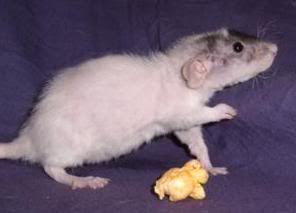 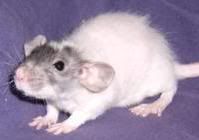
Husky
The rat should have as symmetrical markings as possible. The belly
should be white. The head should have an inverted V blaze, that covers the whisker pads and comes close to the eyes without
touching them and comes to a point between the ears. The jaw line and underside of the head must be white. From the head,
the color runs back and covers the ears ands goes along the body extending down the sides.
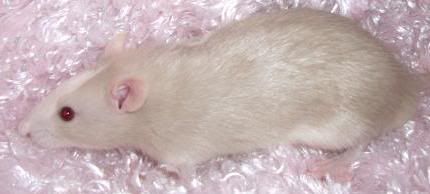
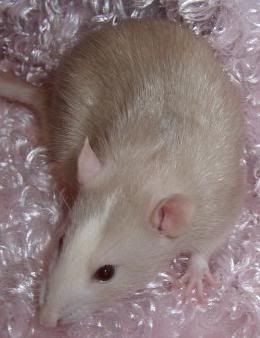
Blue Point Siamese
Body color to be ivory (the darker the better) with a warm blue cast gradually and evenly shaded
over the saddle and hindquarters towards the belly, being darkest at the base of the tail. The points (nose, ears, feet, tail,
and tail-root) to be a medium slate blue. They should not have a definite or distinct line of demarcation but rather a toning
or merging with the remainder of the coat. There should be no white hairs, blotches, streaks. Eyes red or ruby.
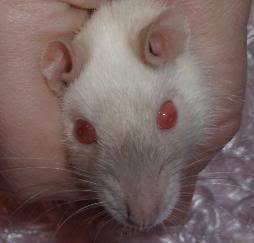
Chocolate Point Siamese:

Black Eyed Siamese: Everything of a regular Siamese except has Black Eyes.

HIMALAYAN - Body color to be white, free from stains and even throughout. The points to be a rich dark sepia (as
dark as possible). Eyes red.
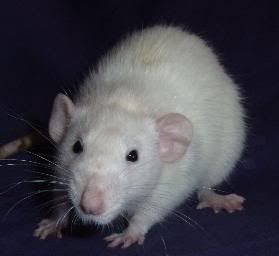
|
 |
|
Down Under
The rat has a normal hood, Berkshire, or variegated marking,
and the same marking matches on their belly.
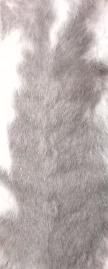
Berkshire
Berkshire rats may be shown in any recognized color. The top color
is to be judged as the recognized color. Markings are the colored top with a completely white belly, white feet and tail.
There should be an even line between the top and bottom color. The white markings should be a pure clean white, and not extend
up the past the sides *Past the sides is a Variberk*
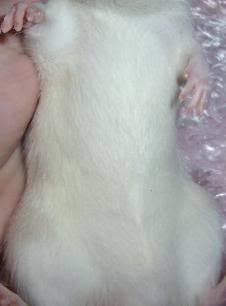 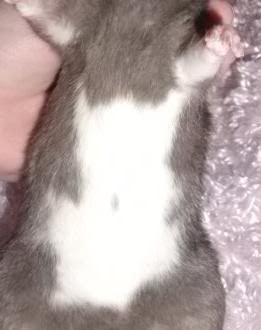
Dalmatian
Dalmatian rats may be shown in any recognized color. Markings
will be similar to the Variegated mice with color splashes on a white background, free from any solid/clear-cut markings.
The splashes should be numerous and ragged in outline, but about equal in size, and well distributed over the entire body.
Hooded
The sides, legs and feet should be a pure clean white, free from spots or brindling. The hood should cover
the head, neck and shoulders without a break, showing no white on the throat or chin, and should run in an even line around
the body. The spine marking should extend in an unbroken line from the hood to the tail, be of moderate width (approx.1/4
the size of the back), and be free of ragged edges or brindling. The tail should be colored at the base, then white to the
end.
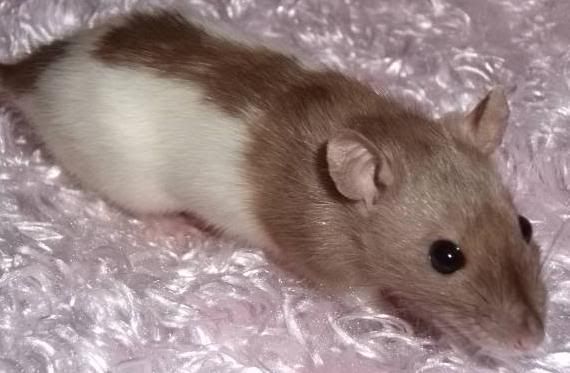 Hooded Down-Under
Hooded Down-Under
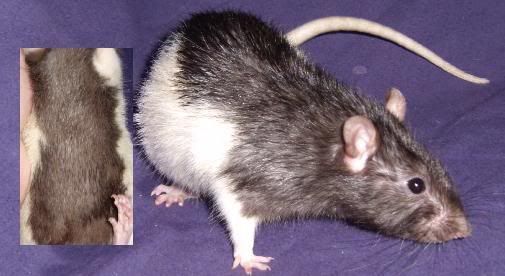
Mask
The body is to be a pure, clean white, free from spots or brindling.
A colored mask to cover the face, to include just around the eyes and above the nose, not to extend down the sides of the
face onto the jowls, under the chin or past the ears.
Merle
Merle rats may be shown in any recognized color. The
unique feature is a pattern of dark splash-spots distributed evenly throughout the entire lighter background color so as to
resemble a merle dog. The splash should be numerous and distinct. Splashs will be less prominent on a non-silvered background
color. Eye color to correspond to the body color.
Picture Taken By Amy @ Camarattery
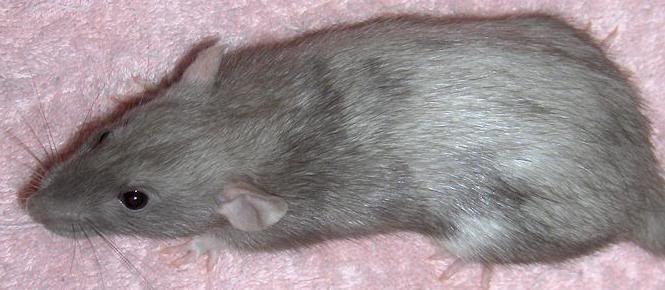
Russian Blue Point Siamese
Body color to be ivory with a deep gray cast
(the darker the better) gradually and evenly shaded over the saddle and hindquarters towards the belly, being darkest at the
base of the tail. The points (nose, ears, feet, tail, and tail-root) to be a dark gray-blue. They should not have a definite
or distinct line of demarcation but rather a toning or merging with the remainder of the coat. There should be no white hairs,
blotches, streaks. Eyes red or ruby.
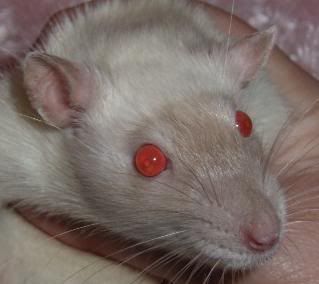
Seal Point Siamese
Body color to be medium beige gradually and evenly shaded
over saddle and hindquarters towards the belly, being darkest at base of tail. Tail color to extend down the length of the
tail. Belly to be light beige. Points to be rich dark sepia and to shade evenly into the body color. Eyes red or light ruby.
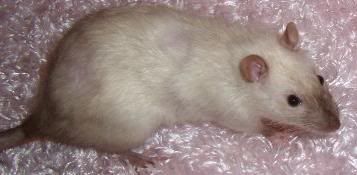 
|
|





















